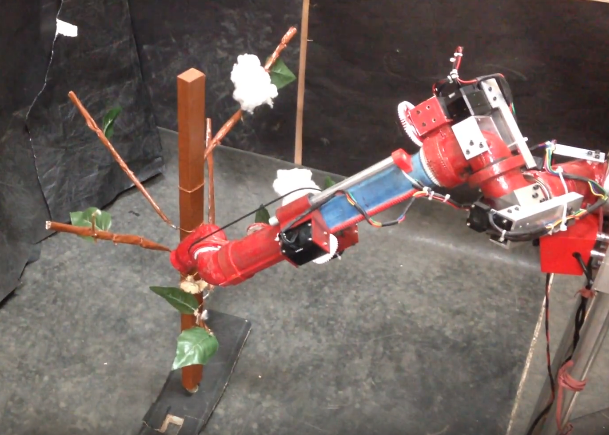It is rare to see those with tech experience moving out of the field and into more hands-on vocations, but that’s exactly what Manohar Sambandam did.

Manohar Sambandam, Founding Partner and CEO at Green Robot Machinery
The entrepreneur-turned-farmer has ditched the computer for the combine harvester—kind of—and is revolutionising the way crops are harvested by introducing a cotton-picking robot.
The idea was born after suffering successive lost crops due to the lack of farm labour. Despite his rice crop finishing a whole two weeks before anyone else’s there was no one to harvest it and due to the restrictions on the use of paddy harvesters, he was unable to bring one in.
“The machines will only come if there are enough people who are going to use it. So I actually lost the crop the first season,” he said.
The lack of labour burned him again after growing a premium breed of cotton, more expensive than rice, but burdened with problems. “I wasn’t able to get people to pick, as this particular breed of cotton does not burst very well. When you pick, you have to use your hand, the shells create a sharp edge, and you can hurt your hand. People were not willing to pick it,” he said.
In a country that is rapidly developing in regards to its use of technology, traditional jobs such as farming have been left in the dust. Just because India has embraced the use of technology, doesn’t mean that other sectors have to be neglected—but they have been, and farmers are taking the biggest hits.
Sambandam’s cotton-picking robot, the first of its kind in India, has been developed by his startup Green Robot Machinery, a recent winner at the Elevate 100 program held in Bengaluru at the end of August. Last year it received funding and incubation from Villgro, after Sambandam has put Rs 50,000 of his own money into the project.
The problems that many farmers face in India, compared with the likes of the UK and US, is the conditions do not allow for synchronised bloom to be able to harvest all different types of cotton at once. Instead the cotton blooms at separate intervals.
Currently, the robot aims to bring advanced technology for cotton picking. It mimics the human behaviour in cotton picking by identifying bloomed cotton, but with a higher productivity rate than the average human can manage. One would assume the robot won’t complain about its hands hurting, either.
In the future, the machine can be customised for different types of crops such as chili, capsicum, brinjal and okra, which also require a large human workforce.
The robot is programmed to the topography of a typical cotton plant – ideally with around twenty branches and about three feet in diameter. The current robot uses six degrees of freedom for maximum range of motion and to be able to reach the cotton plant from the side. Using path-planning algorithms and inverse kinematics—a technique also used to create realistic movement in film animation—the arm is guided to the cotton and avoids the branches.
Using an imaging process, the robot is able to identify the cotton without needing to implement machine learning codes and creates a 3D model of the plant to assure it is only the cotton that is picked, not the branches or anything that might have made its home there.
https://www.youtube.com/watch?v=-XWaIomq-fk
Using a vacuum tube, the machine sucks the cotton all in one go in a more time-efficient manner. The target is to pick a cotton ball every two seconds, with four arms working at the same time.
But, despite the amount of time saved by doing this, it will still need a human to control it, as navigating through the rows of cotton must be done manually. Still, it will prove to be a much faster procedure than what is currently accepted in India’s cotton fields. The team wants the machine to be able to pick between 250 kg and 500 kg everyday, which is up to ten times more efficient than manual labour.
Is is going to catch on though? Farming as a Service (FaaS) is predicted to be a top agritech trend to look out for in India this year, and that’s exactly what Sambandam wants the robot to be. But for it to be successful it needs investment and trust from those who will bring it to the forefront.
There is a lot of investment in agritech in India, but in regards to farm automation, interest seems to be slow to sprout. There will still be challenges such as a drop in land holdings and lack of mechanisation but with the right support, Green Robot Machinery could bring about this harvest earlier than expected.
Right now, Green Robot Machinery have found a wanting need in India’s farming industry. The machine is not yet complete, Sambandam believes it will need two or three crop cycles before the robot is ready for production. But this time will give the company the chance to perfect the model by adding more arms and perhaps adding more sophisticated mechanics. Customers can expect to have it on their hands by the end of the year.











